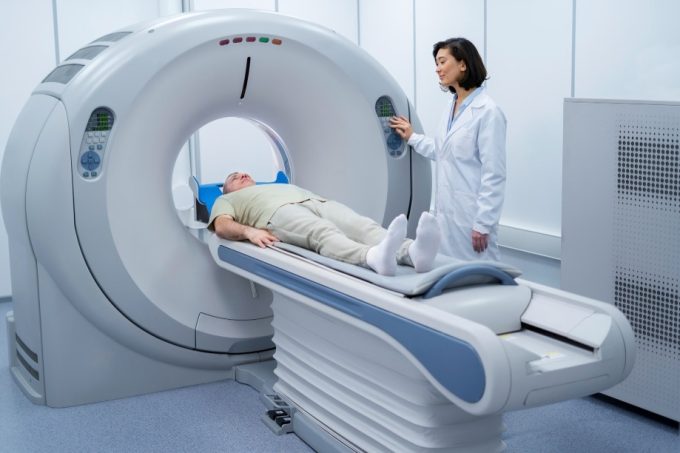Learn what to expect when visiting the Emergency Department. Learn More
-
CALL: +971 4 3454040

- Medical Technology
- July 30, 2025
- 5 MINS READ
Introduction: A New Era in Medical Imaging
In today’s fast-paced healthcare landscape, AI in Radiology is emerging as a game-changing innovation. Radiology, which was once entirely dependent on human interpretation, is now undergoing an unprecedented transformation thanks to artificial intelligence. From faster diagnostics to improved accuracy, this shift is redefining the future of medical imaging.
While traditional radiological methods remain essential, the integration of AI technologies is streamlining workflow, reducing diagnostic errors, and ultimately enhancing patient outcomes. Moreover, as imaging data continues to grow in volume and complexity, AI-driven tools have become indispensable allies for radiologists worldwide.
What Exactly is AI in Radiology?
To begin with, AI in Radiology refers to the application of machine learning and deep learning algorithms to assist in analyzing medical images such as X-rays, CT scans, MRIs, and ultrasounds. These AI systems are trained to detect anomalies, compare findings against extensive datasets, and even suggest preliminary diagnoses.
Some key functions of AI in Radiology include:
-
Image segmentation: Identifying specific organs or tissues within an image
-
Pattern recognition: Detecting subtle abnormalities that may go unnoticed
-
Predictive analytics: Assessing risk factors and forecasting disease progression
-
Workflow automation: Prioritizing urgent cases and reducing manual work
With such capabilities, it’s no wonder healthcare providers are increasingly relying on AI tools to supplement human expertise.
Enhancing Imaging Accuracy: The Core Benefit
One of the most notable benefits of AI in Radiology is the improvement in diagnostic accuracy. Radiologists are skilled professionals, but even the most experienced ones can face fatigue or misinterpret subtle signs. This is where AI steps in.
In fact, studies have shown that AI-assisted image interpretation can reduce diagnostic errors by up to 30%, especially in areas like breast cancer detection and lung nodule identification. Additionally, AI systems can cross-reference current scans with thousands of similar cases within seconds, a task no human can accomplish in real time.
Furthermore, AI not only catches abnormalities but also ensures they are highlighted consistently and objectively, minimizing subjectivity in diagnoses.
Speeding Up Diagnosis Without Compromising Quality
Another important aspect of AI in Radiology is its ability to expedite diagnosis. In emergency settings, time is often the most critical factor. AI tools can quickly triage imaging scans, flagging urgent cases like strokes or internal bleeding for immediate attention.
This results in:
-
Faster treatment decisions
-
Reduced wait times for patients
-
Improved resource allocation in hospitals
Moreover, radiologists can then dedicate more time to complex cases rather than routine analysis, leading to an overall increase in efficiency without compromising on accuracy.
AI and Radiologist Collaboration: Not Replacement but Augmentation
It’s essential to clarify that AI in Radiology is not here to replace human radiologists. Rather, it complements their work, enhancing their capabilities. AI offers a second pair of “eyes,” one that never tires, never skips a beat, and constantly learns from new data.
Radiologists can leverage AI to:
-
Double-check diagnoses
-
Obtain differential diagnoses faster
-
Access relevant literature or similar past cases
-
Optimize report generation
In this way, AI becomes a collaborative partner, supporting radiologists while preserving the human judgment that remains vital in complex cases.
Real-World Applications Across Specialties
The integration of AI in Radiology is visible across multiple imaging specialties. Let’s look at how it’s making a difference:
-
Mammography: AI helps detect microcalcifications and small tumors in breast tissue earlier than manual review
-
Chest Imaging: It can spot early signs of tuberculosis, pneumonia, or lung cancer
-
Neurological Imaging: AI can rapidly detect ischemic strokes and guide clot retrieval procedures
-
Musculoskeletal Imaging: Assists in identifying bone fractures or joint abnormalities often missed in conventional views
As these systems evolve, the potential applications of AI will only expand.
The Role of Medical Specialists Center
Organizations like Medical Specialists Center are at the forefront of embracing AI-based technologies in radiology. By integrating these systems into their diagnostic processes, they ensure faster, more precise outcomes for their patients.
Their commitment to innovation reflects a broader shift in the healthcare industry, where embracing technology isn’t optional—it’s essential.
Challenges and Ethical Considerations
Despite its promise, AI in Radiology faces certain challenges:
-
Data privacy: Protecting patient information is critical when AI models use vast data
-
Bias in algorithms: If not trained on diverse data, AI can give skewed results
-
Dependence risks: Overreliance may lead to complacency in human analysis
Therefore, a balanced, transparent, and continuously monitored AI application is necessary for sustained trust and success.
Conclusion: A Smarter Future for Radiology in Dubai
To conclude, AI in Radiology is not a futuristic concept—it’s already reshaping how we diagnose and treat diseases. With AI-powered tools, radiologists can work smarter, not harder, delivering faster, more accurate, and more reliable results.
As healthcare systems continue to evolve, especially in advanced hubs like medical centers in Dubai, the fusion of AI and radiology will play a pivotal role in shaping a future where precision, speed, and patient care go hand-in-hand.
FAQs: Common Questions About AI in Radiology
Q1. Is AI in Radiology safe to use for diagnosing serious diseases like cancer?
Answer: Yes, AI tools undergo rigorous testing and validation before implementation. When used alongside human expertise, they significantly reduce the chances of missed or incorrect diagnoses in serious conditions like cancer.
Q2. Will AI replace radiologists in the future?
Answer: No. AI is designed to assist—not replace—radiologists. It handles repetitive or time-sensitive tasks, allowing radiologists to focus on critical decision-making and complex cases.
Q3. How is patient data protected in AI-driven radiology?
Answer: Data privacy is a top priority. Healthcare providers use encrypted systems, secure networks, and adhere to strict compliance regulations (such as HIPAA) when integrating AI technologies.
Takeaway: The adoption of AI in Radiology represents a leap forward in diagnostic precision and healthcare delivery. By combining the strengths of human intelligence and machine learning, the future of radiology looks brighter—and smarter—than ever before.



